Gorbachev calls Reagan:
- Please accept our condolences over the death of the Challenger shuttle.
- “Challenger” has not yet taken off, start-up in two hours.
- Oh, damn, I'm sorry! Damned time difference. (Joke of 1986)
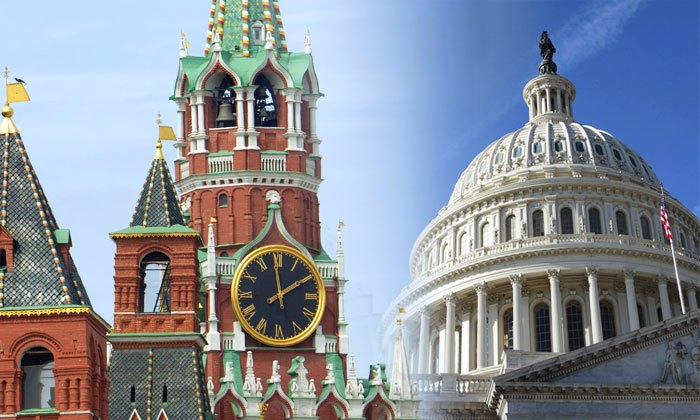
Of course, the death of the shuttle with the crew on board should not be the subject of jokes, even evil ones. The anecdote is important in the light of the article, as it contradicts the facts. In 1986, Gorbachev could not call the White House, because the telephone connection was established later. Mikhail Sergeevich could only write about it through a special emergency communication channel known as the “hot line”.
Appearance of communication
The ability to organize each other for the construction of something truly pompous is a distinctive feature of the Soviet state; heights have been achieved in this area. The entire history of the Soviet Union is full of examples of grand projects and construction projects, such as the White Sea Channel or the canal on the Volga-Don isthmus. They liked to build canals, what does the legendary BAM cost (and the treasury cost)? The philosophy of building socialism in every way contributed to communications within the country, but, alas, did not give anything for communication with the outside world. In the early sixties, it happened that the "outside world" itself knocked on the blind doors of the iron curtain. And they were ajar for a moment.
The emergence of the idea of a “hot line” between the United States and the USSR dates back to 1954. But precisely the end of the summer of 1963 will be the day of the launch of the “hot line” - an emergency connection between Washington and Moscow. The August day went down in history as the start of detente in international relations, which was strenuously tense throughout 1962 (the height of the Caribbean Rocket Crisis, when the world hung in the balance). A quick reaction and the provision of an answer to requests between states were needed, but it took at least 12 hours to receive and decode a message of about 3 thousand characters, which was unacceptable. Indeed, by the time the message was completely readable and the answer was prepared, another one had already arrived with a more aggressive content.

For the first time, Michael Bon, the former head of The Washington Post, spoke about the history of a unique communication channel between the two superpowers. The premises where the “hot line” terminals were previously installed were called “situational rooms”. Bonu had to work with several American presidents, according to his story Lyndon Johnson, Richard Nixon, Jimm Carter and Ronald Reagan exchanged dozens of times during periods of acute international crises with a hotline with the leaders of the USSR - Alexei Kosygin, Leonid Brezhnev and Mikhail Gorbachev.
Initiative is not punishable
The initiative to create a bond belonged to the Americans, namely, the chief editor of Parade magazine, Jess Gorkin, who on March 20, 1960 published an open letter to US President Eisenhower and at the same time Nikita Khrushchev. Gorkin called on the leaders of the two powers to establish a direct communication channel in case of an emergency. Three years later (already during the Caribbean crisis), this idea fascinated President Kennedy. After negotiations with Moscow in June 1963, the parties signed a corresponding agreement in Geneva. Officially, the line was called the Direct Communications Link (DCL), often called MOLINK (from Moscow Link).
ETCRRM (Electronic Teleprinter Cryptographic Regenerative Repeater Mixer)
The first implementation of the “hot line” consisted of two electromechanical printing machines implementing a duplex communication method, one of which was a backup. On each side there were two teleprinter with the Latin alphabet and two with Cyrillic.
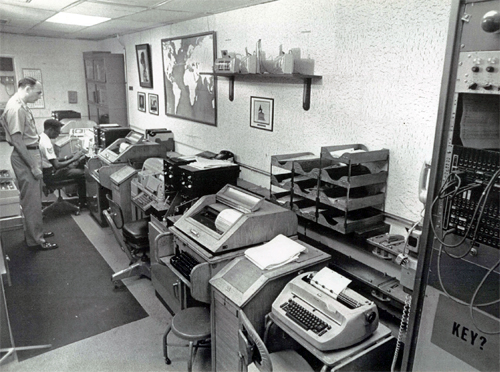
On each side of the line was protected by four ETCRRM encryption machines. Instead of using encryption devices manufactured by the United States or the USSR to encrypt messages, the Norwegian STK ETCRRM encryption machines were chosen to keep neutrality and impartiality in this matter.
 STK factory
STK factoryETCRRM was one of the first online / offline OTT (One-Time-Tape encryption, the essence of such encryption is simple: the one-time key used is equal to the transmitted data, the text is encrypted and no one can decrypt it) of the encryption machines developed in 1953 Norwegian STK factory in Oslo. The machine used the Vernama cipher and mixed clear text with random characters from the key tape. The idea of the car belonged to Bjørn Rørholt, an engineer, a military officer and a veteran of the Norwegian army. In close cooperation with STK, this idea was further developed, with the result that in 1952 a patent was obtained for a new One-Time Tape (OTT) encryption machine.
 ETCRRM-II Version
ETCRRM-II VersionSoon, other NATO countries became interested in the encryption machine, ETCRRM became the standard cryptographic device of these countries. Over the years, three versions of ETCRRM were developed and released, the improved versions were slightly different from their predecessors. Identified simply - by adding the Roman number (I, II or III) to the name of the model.
In the ETCRRM-II version (in the figure above), the standard Creed tape drive was installed on the front panel of the device, but there were also versions in which the reader was disconnected. The key tape was fed into the reader from a reel mounted on the right side of the machine.
 British One-Time Tape (OTT) 5-UCO Encryption Machine
British One-Time Tape (OTT) 5-UCO Encryption MachineThe machine was developed by STK as an alternative to the outdated British 5-UCO and the American SIGTOT. ETCRRM became one of the most popular encryption machines of the 1950s in the NATO countries. It was she who was used since 1963 jointly by the United States and the USSR for the Washington-Moscow “hot line”, until Siemens M-190 came to replace it in 1980. By August 1955, the ETCRRM was produced at 200 cars a month at a cost of $ 1,200, its popularity is justified by the price, since the British 5-UCO at that time was worth $ 12,000.
 American One-Time Tape (OTT) Encryption Machine SIGTOT
American One-Time Tape (OTT) Encryption Machine SIGTOTThe ETCRRM encryption machine is a One-Time Tape (OTT) using a Varnam cipher or “one-time notebook” scheme, it could not be hacked, it is absolutely safe. Since representatives of the Soviet Union insisted on creating their own keys, it was decided that each side would create its own tapes with keys. After that, these tapes were delivered by special couriers to the embassy, and then to their destination.
Text mode and first message
On the day of the launch of the “hot line” with the help of a teletype machine connected to the line, the Americans sent the first comic message to Moscow, a phrase containing all the letters of the Latin alphabet with numbers: “The quick brown fox jumped over the lazy dog's back” / Quick brown fox jumped over the back of a lazy dog. In turn, Moscow sent a poetic description of the sunset.
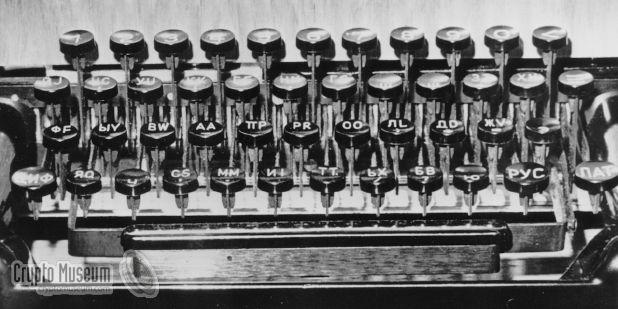
In the image above - the keyboard of the Russian teleprinter, which in fact was the East German T-63. The T-63 was delivered to the Pentagon (Washington) on August 26, 1963.
Prior to the creation of the communication line, the algorithm of actions was as follows: the diplomats of one side informed the embassy of the other, then the embassy prepared an encryption for the management. The process took from several hours to several days. The original hotline did not look like a familiar phone. These were two — for security — secure communication lines: via a telegraph cable that ran across the bottom of the Atlantic through the capitals of the Nordic countries. Wireless has sent messages via Tangier. The parties agreed in advance to use this system only in exceptional cases.
The entire communication system operated faster than the traditional one. Messages were sent in the original: having received the text in Russian, it was translated in Washington - two translators worked on it, the options were then compared. Not the White House was directly connected with the Kremlin, but the Pentagon, in which the officer in charge of the Russian language was constantly on duty.

Teletype communication between Washington and Moscow was carried out by cable, laid across the bottom of the Atlantic and passing through London, Copenhagen, Stockholm and Helsinki. The radio channel, which used the relay station in the Moroccan city of Tangier, served as a backup channel. Although the line was cryptographically secure, it was physically damaged several times: a Finnish farmer accidentally plowed a field where a cable passed, with a bulldozer.
 Modern submarine cable
Modern submarine cableIf you look at the diagram of cables laid along the ocean floor, you unwittingly imagine a sea monster that has entangled all continents with its tentacles. Attempts to lay the cable on the surface of the ocean floor, dates back to the XIX century. There is evidence that the first attempts to connect the UK and the US with the transatlantic telegraph cable failed in August 1858, but within a month the connection was lost. The reason, most likely, was the violation of cable waterproofing, corrosion and breakage. The stable connection between the Old and the New Worlds was established only in 1866.
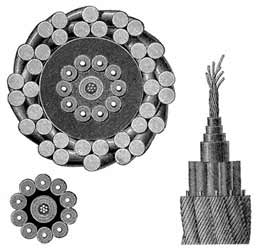 Transatlantic telegraph cable design 1865-1866
Transatlantic telegraph cable design 1865-1866A feature of the production of optical deep-sea cables is the placement of cable plants near the ports, as close as possible to the sea. Immediately for two reasons: a huge tonnage of finished products and the resulting problems of logistics. One kilometer of cable can reach a mass of several tons. The functional features of the cables, on which the intergovernmental communication was based and continues to be, are no different from terrestrial. The secret is in the device of the cable itself, which should keep working at a depth of more than five kilometers. The deep-water cable must have a number of basic characteristics: waterproof, durable due to the enormous pressure of water, the ability to withstand bends and torsion.
The first exchange of messages
The first exchange of messages on the hotline occurred in the summer of 1967 during the Arab-Israeli wars. June 5, 67 Israel began hostilities. On that day, US Secretary of Defense Robert McNamara raised President Lyndon Johnson at seven in the morning. The news came through a “hot line” from Moscow, namely from the Soviet Prime Minister Kosygin, with a request to exert pressure on Israel to stop the war in the Middle East. During the six days of the war itself, Washington and Moscow exchanged 20 messages.
However, the "hot line" was used not only in crisis situations. President Johnson ordered the transfer of information about the flights of American spacecraft under the Apollo project to the Soviet Union. The next "subscribers" of the emergency line were Nixon and Carter with Leonid Brezhnev, and the last Reagan and Gorbachev used the "hot line" in 1971 during the military conflict between India and Pakistan.
Hotline upgrade
The first time the “hot line” was improved in 1971, now it has satellite channels through the American Intelsat IV and the Soviet communications satellite Molniya-2.
 Intelsat IV
Intelsat IVThe Intelsat IV series of satellites launched from Cape Canaveral in the early 1970s represented the fifth generation of geostationary satellites developed by the Hughes Aircraft Company, starting in 1963 with the Syncom II, the world's first synchronous satellite. Intelsat IV weighed more than 595 kg and had a diameter of more than 5.31 m.

The satellite communications system, Molniya-2, which Boris Suprun worked on, used a centimeter wave band, which helped to increase the transmission capacity. In 1971, the Molniya-2 satellite was launched into the same orbit as the Molniya-1, only worked in the international satellite frequency range 4-6 GHz, the Orbit ground stations were re-equipped, the improved Orbit -2 ".

The installation and testing of new communication lines took several years, but finally they entered into force on January 16, 1978. New satellite channels were much less vulnerable than cable through Europe.
In 1980, the machines were replaced with newer models, and the ETCRRM encryption machines were replaced with Siemens M-190 stations. Although the M-190 was developed in the early 1960s, it was 10 years younger than ETCRRM. M-190 stations were tested back in 1976, but several years passed before they were approved.

 Siemens M-190
Siemens M-190Technical characteristics of Siemens M-190:
- data transfer rate - 45.45, 50 or 75 baud (368, 400 or 600 h / min)
- linear voltage - 120 V
- linear current - 40 mA
- power - 24V and 120V
- dimensions - 27 x 33 x 61 cm
- weight - 25 kg
 Siemens M-190
Siemens M-190Siemens M-190 is a telegraph encryption machine created by Siemens in the early 1960s. Her work is based on the Vernam cipher, so the machine belongs to the so-called mixer class or OTT. M-190 can be considered as the successor of the military Siemens T-43.
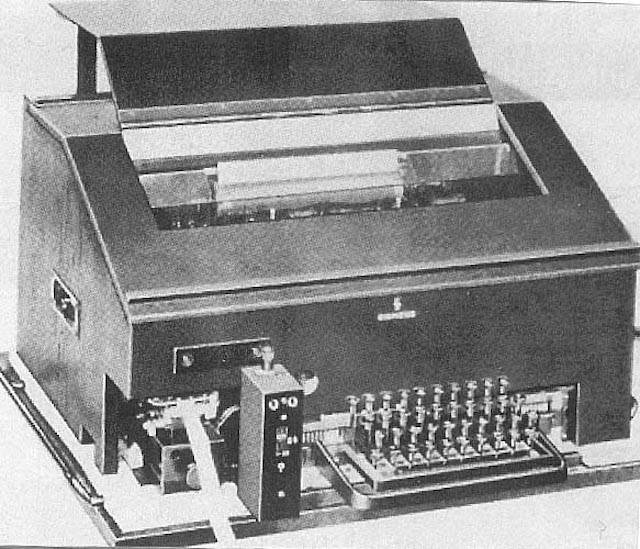 Siemens T-43
Siemens T-43In the German army, the car was known as LOMI, after its predecessor - Lorenz. The M-190 could be used both offline and online. For offline use, plaintext was previously recorded on a blank paper tape using a standard teleprinter (Siemens T-100). Then the tape is reproduced using a tape reader (punched tape).

In online mode, the teleprinter was connected directly to the M-190, and, located in front, the tape reader was not used. Instead, the tape with the key automatically moved one position each time the operator typed a character on the keyboard. Online use of encryption machines was considered not entirely safe, it is impossible not to take into account the speed of character input by the operator. In addition, the operator could suddenly leave the workplace. To avoid errors in clear text, the M-190 had two large colored lamps in front of the right of the control panel. When the red lamp was on, the system worked in plaintext mode. Turning on the green indicator meant that the encryption and transmission of the text in a secure mode. Despite the fact that the M-190 was compatible with almost any model of a teleprinter, it was usually used in conjunction with the modern color Siemens T-100.
On July 17, 1984, the United States and the USSR signed an agreement on updating the DCL with facsimile equipment after negotiations that began in May 1983 on the initiative of President Reagan. It was decided that identical Group III faxes, operating at 4800 baud, would be installed on both sides. The fax is able to send handwritten messages, charts, maps and photos, as well as transmit a page in 6-15 seconds, which is 12 times faster than a teleprinter. From the middle of 1985, these communication channels began their work and served for several years. In the same year, it was by fax that President Reagan received 15 pages of Gorbachev’s handwritten message, which did not spare the time either, to go through all the problematic issues of Soviet-American relations.
Later, the USSR upgraded the channel of communication with the new geosynchronous satellite Horizon, as a result of which the Americans no longer needed to switch between the Molniya satellites every four hours. In 1996, the Russians switched to the Molniya-3 satellite.

In the photo, in the foreground - Siemens M-190. For several years, the M-190 remained the main link between the United States and the USSR, until the fax machine was deemed reliable enough to replace it. In 1988, shortly before the collapse of the Soviet Union, the M-190 was replaced.
In 1991, the Kremlin and the White House established a direct telephone connection, which Presidents George W. Bush and Boris Yeltsin began using. Today, in case of urgent need, the presidents also communicate by telephone.
Secure Email

In 2007, work began on improving the forward link (DCL). The previous data line was replaced by a dedicated computer network; email and chat became available for data transfer. Chat is used by operators to coordinate; officially, email is used to send letters, which allows you to send text messages, scanned images and files.
The photo above was taken at an event dedicated to the 50th anniversary of the “hot line” on August 30, 2013. Teleprinters and fax machines have been replaced by modern computers with secure e-mail. It is interesting what is in the two wooden boxes in front. Keys?
The hotline was mainly intended to inform the other party in the event of incidents, (nuclear) accidents and unexpected actions. Just a few months after the launch of DCL, it was first used by Americans on November 22, 1963, after the assassination of President John F. Kennedy.
The hotline was used during the following international conflicts:
- 1963 - The assassination of President Kennedy
- 1967 - Six Days of War between Egypt and Israel
- 1971 - war between India and Pakistan
- 1973 - Yom Kippur War
- 1974 - the invasion of Turkey in Cyprus
- 1979 - the invasion of Afghanistan
- 1981 - the threat of invasion of Poland
- 1982 - Israeli invasion of Lebanon
- 1991 - Gulf War
- 2003 - consequences of the war in Iraq
The first official use of the “hot line” of the USSR was on June 5, 1967, at the beginning of the six-day war between Egypt and Israel. As mentioned earlier, these negotiations consisted of 20 messages.
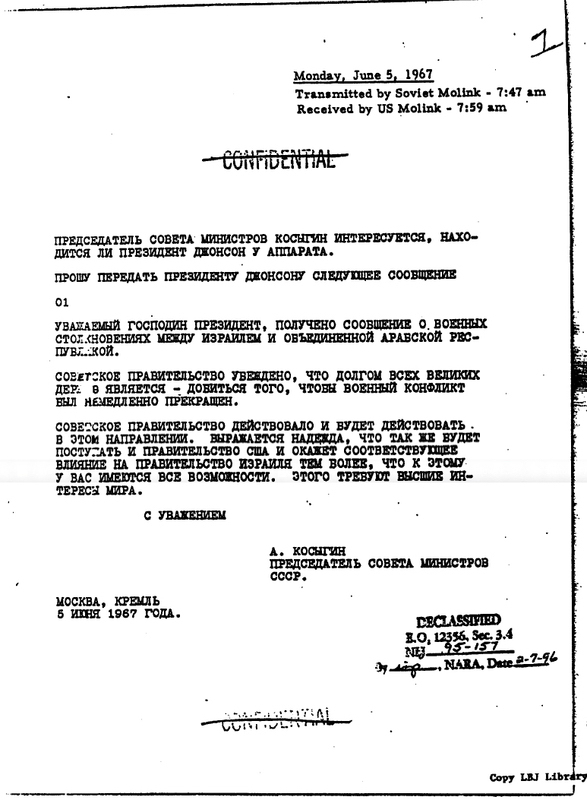
Red phone
Contrary to popular belief, the “hot line” has never been represented by a red telephone set, which could be used to transmit conversations between Washington and Moscow in case of emergencies. Nevertheless, the red phone as an exhibit is in the library and the Jimmy Carter Museum in Atlanta (USA). On this phone there is no dial for dialing, the inscription below states that it was used in communication via the Moscow-Washington hotline during Carter’s White House.

Red phone is often shown in various films for communication of world leaders in crisis situations. Perhaps because in the minds of the "hot line" Washington-Moscow is associated with the red apparatus. There are at least several reasons why voice transmission of messages in real time during periods of crises was unacceptable. First of all, in the 1960s it was very difficult to securely protect an encrypted voice message. And to avoid misunderstandings caused by the language barrier, it was even more difficult. Sending written messages (by teleprinter, fax or computer) provided time for proper translation and correct interpretation.
On September 15, 1987, before the collapse of the Soviet Union and the end of the Cold War, the United States and the USSR created the so-called Center for Nuclear Risk Reduction (NRRC) to build confidence by sharing information about their nuclear arsenals. For the exchange of information about nuclear programs, a direct line of communication was created, which resembled a “hot line”.
Initially, this line consisted of teleprinters with a one-time tape encryption, but later the devices were replaced with facsimile equipment (fax), IBM computers were used for encryption.
Cyber security
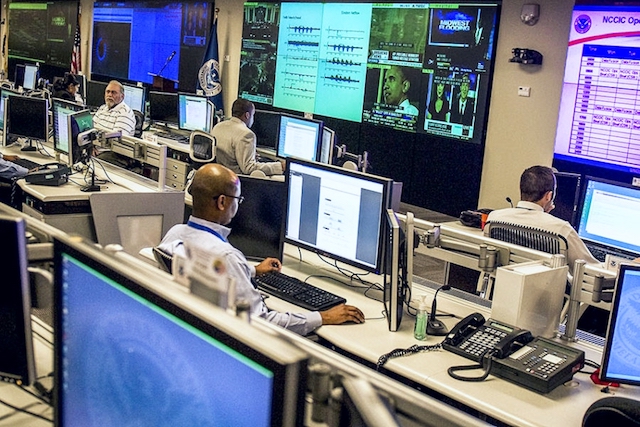
Currently, the following official links between the United States and Russia are known:
- Hot line
- Direct Voice (DVL)
- Government Communications (GGCL)
- Nuclear Risk Reduction Center (NRRC)
- Line for International Relations (FAL)
A series of myths is connected with the “hot line”, the first one starts with its name. Initially, it was neither direct nor through a red telephone, these were text messages, encrypted messages. The means of communication over the course of time have been modified, improved, and the speed of data transfer has gained momentum.

This memorial sign, issued in August 2013, was timed to the 50th anniversary of the direct line of communication between Washington and Moscow. But he will never be handed to anyone and will remain only for history. Advanced technical solutions that excited the engineering minds of the early sixties remain behind. Perhaps this is natural, technology will transform the world, time changes reality. The reality is that the emergency wire connection established between the White House and the Kremlin as early as August 1963 is functioning properly. It has long been not used, but maintained and tested.
As advertising. These are not just virtual servers! This is a VPS (KVM) with dedicated drives, which can be no worse than dedicated servers, and in most cases - better!
We made VPS (KVM) with dedicated drives in the Netherlands and the USA (configurations from VPS (KVM) - E5-2650v4 (6 Cores) / 10GB DDR4 / 240GB SSD or 4TB HDD / 1Gbps 10TB available at a uniquely low price - from $ 29 / month , options are available with RAID1 and RAID10) , do not miss the chance to place an order for a new type of virtual server, where all resources belong to you, as on a dedicated one, and the price is much lower, with a much more productive hardware!
How to build the infrastructure of the building. class c using servers Dell R730xd E5-2650 v4 worth 9000 euros for a penny? Dell R730xd 2 times cheaper? Only we have
2 x Intel Dodeca-Core Xeon E5-2650v4 128GB DDR4 6x480GB SSD 1Gbps 100 TV from $ 249 in the Netherlands and the USA!